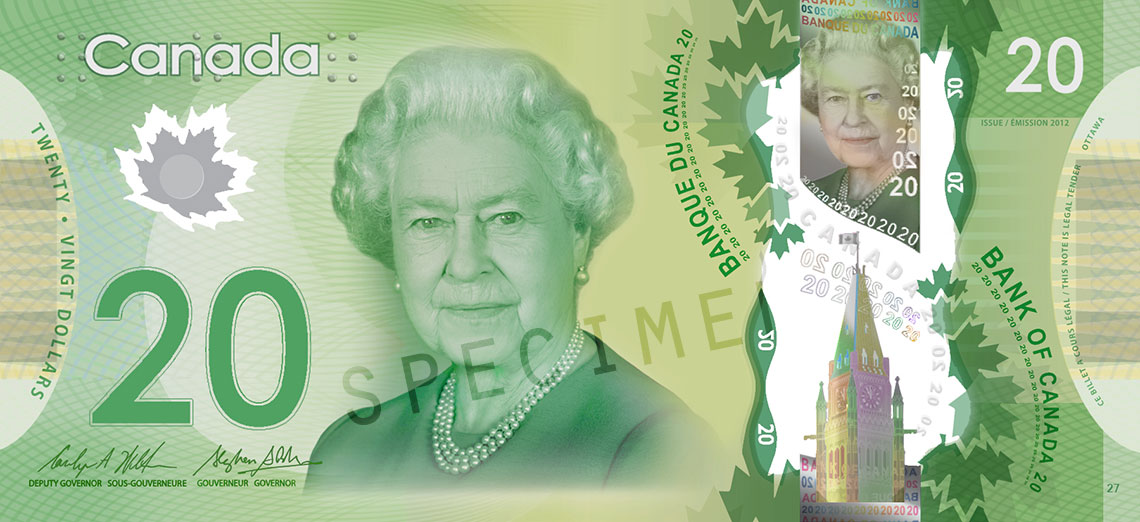
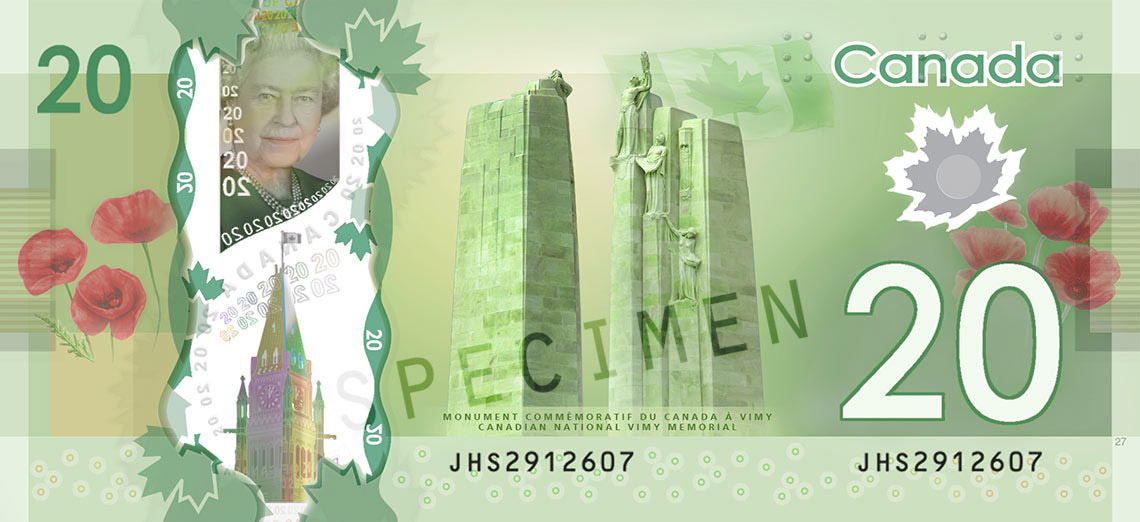
The Canadian National Vimy Memorial is featured on the polymer $20 note as a tribute to Canada’s contributions and sacrifices in military conflicts throughout its history. Located on the site of the 1917 Battle of Vimy Ridge, the Canadian National Vimy Memorial in France was erected in honour of Canadian service during the First World War.
The Battle of Vimy Ridge
In April 1917, all four divisions of the Canadian Corps fought together for the first time and successfully captured Vimy Ridge, following several failed attempts by other Allied forces. The success came at a high cost–nearly 3,600 Canadians lay dead and a further 7,000 wounded. The victory at Vimy was not only crucial in ending the First World War, but sparked a coming of age for Canada–giving a young nation a sense of confidence and identity. Of Vimy, Canadian Brigadier-General A.E. Ross famously commented, "in those few minutes I witnessed the birth of a nation."

The portrait

Feel the raised ink
The portrait of Queen Elizabeth II is an engraving by Jorge Peral, Vice-President, Design and Master Engraver with Canadian Bank Note Company Limited. It is based on a photograph taken by Ian Jones, specially commissioned by the Bank and replicated for the holographic image.

The building

Look at the metallic building. Tilt to see it change colour. Flip to see it on the other side
The over 92 metre high Peace Tower was the last section of the Centre Block of Parliament to be completed. Designed in an updated form of English Gothic Revival by Canadian architects John A. Pearson and Jean-Omer Marchand, the tower was opened in 1928 on Armistice Day, now known as Remembrance Day. It was named the Peace Tower to honour the thousands of Canadians who sacrificed their lives during the First World War.
The Peace Tower was chosen as the parliamentary building to be paired with the Polymer series $20 note as it was an appropriate match for the Canadian National Vimy Memorial. On the bank note, the time displayed on the clock of the Peace Tower is 11 o'clock to signify the armistice.

The Canadian National Vimy Memorial
The Canadian National Vimy Memorial bears the names of the 11,285 Canadian First World War servicemen with no known resting place in France. The following words are inscribed on the base of the monument: “To the valour of their countrymen in the Great War and in memory of their sixty thousand dead this monument is raised by the people of Canada.”
The monument is adorned with 20 allegorical figures. Among them is a group known as "The Chorus." They represent the virtues of Peace, Justice, Hope, Charity, Faith, Honour, Truth and Knowledge. Reaching upward with a torch, Peace is the highest figure on the monument.
Designed by Canadian sculptor and architect Walter Seymour Allward, the monument features two pylons that stand 30 metres high. With a maple leaf carved in one and a fleur-de-lis in the other, the pylons represent the sacrifices of people from Canada and France.
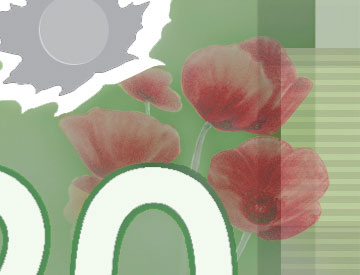
Poppies
This artistic rendering of poppies symbolizes remembrance and honours Canada’s military men and women. The presence of red poppies in battlefields and burial grounds throughout Europe during the First World War inspired the symbol of remembrance that we know today. Mourning the death of a friend, Canadian military doctor and artillery commander Major John McCrae wrote “In Flanders Fields,” the now-famous poem that reflects on the living presence of poppies in a landscape devastated by war.
Today, the poppy has become an international symbol of remembrance and those worn on lapels all over the western world can trace their roots directly to McCrae’s poem.

The Canadian flag
The Canadian flag’s presence here indicates that although the Vimy memorial is not in Canada, it is actually on Canadian soil, granted by the Government of France to the people of Canada, for all time. Vimy Ridge is a 14-kilometre long escarpment that overlooks the Douai plain of northern France, near the city of Arras. The Canadian National Vimy Memorial is located on the highest point of the ridge.
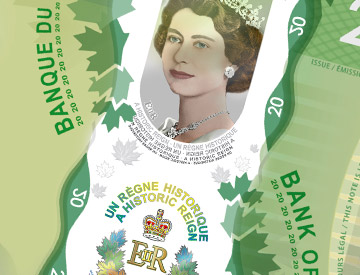
2015 commemorative $20 note

Look at the metallic building. Tilt to see it change colour. Flip to see it on the other side
The commemorative $20 note was issued on 9 September 2015, the day on which Queen Elizabeth II’s reign exceeded that of her great-great-grandmother, Queen Victoria, making her Canada's longest-reigning sovereign.
The commemorative note is a variation of the existing Polymer series $20 note that already features a portrait of the Queen. The difference is that the large window contains new visual elements: metallic portrait of the Queen in 1951, metallic symbols, and text repeating "A Historic Reign • Un règne historique".
Explore eight decades of portraits of Queen Elizabeth II on Canada’s bank notes.
Additional security features
Feel the raised ink on the large number.
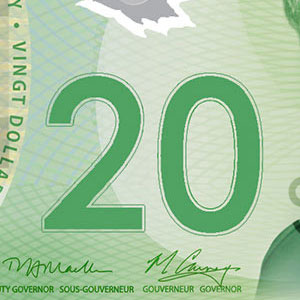
Look at the frosted maple leaf window to see its transparent outline.
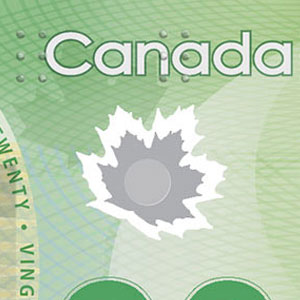
Feel the raised ink on the words "Banque du Canada" and "Bank of Canada."
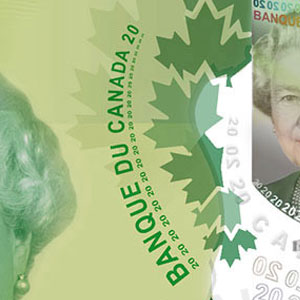
Look at the numbers that match the note’s value and at the word "Canada" that feels slightly raised.
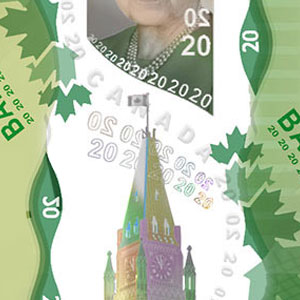
Look at the metallic portrait, it matches the large portrait. Tilt to see it change colour. Flip to see it on the other side.
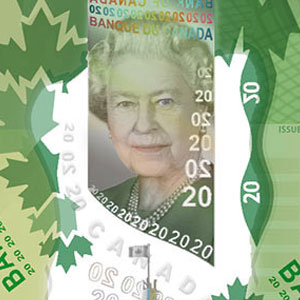
Look for maple leaves that border and cross into the large window.

Bank note specifics
- Portrait: Her Majesty Queen Elizabeth II
- Building: The Peace Tower
- Signatures: Left - T. Macklem, Right - M.J. Carney / Left - Carolyn A. Wilkins, Right - Stephen S. Poloz / Left – T.D. Lane, Right - T. Macklem
- Size: 152.4 x 69.85 mm (6.0 x 2.75 inches)
- Issue date: 7 November 2012
- Theme: Canadian National Vimy Memorial
2015 commemorative $20 note
- Signatures: Left - Carolyn A. Wilkins, Right - Stephen S. Poloz
- Issue date: 9 September 2015
- Theme: A Historic Reign
For more information, visit www.vimyfoundation.ca